TRPV1 channel is a potential drug discovery channel for epilepsy
Epilepsy is one of the most frequent and heterogeneous neurological disorders and it is characterized by several disabilities. Epilepsy is affecting about 3% of people worldwide. Current antiepileptic drugs are only effective in 60% of individuals and many drugs can induce several unwanted side effects in patients. Etiology of epilepsy has not been clarified fully. However, increased intracellular calcium ion (Ca2+) concentration has main role in etiology of epilepsy. Ca2+ passes the cell membrane through different cell membrane channels. One of the channels is TRP superfamily. The family is containing six subfamilies. TRPV1 channel is a member of TRPV subfamily. Capsaicin is a component of hot chili pepper. The TRPV1 channels is activated by different stimuli such as acidic pH, high temperature (≥ 42° C) and capsaicin, causing pain, inflammation and hyperalgesia in peripheral nervous system (Caterina et al. 1997). Is has been well known that hippocampus is main area in the brain for induction of epilepsy. Expression levels of TRPV1 channels in different areas of hippocampus are high (Gonzalez-Reyes et al. 2013). Results of recent studies indicated involvement of TRPV1 channels in epilepsy (Nazıroğlu and Övey, 2015; Cho et al. 2018). In the oral presentation, I discussed novel roles of TRPV1 on the epilepsy induction by the capsaicin. Results of a recent study indicated increased levels of intracellular Ca2+ concentration in hippocampus of epilepsy induced rats (Nazıroğlu and Övey, 2015). They also observed increased levels of intracellular mitochondrial oxidative stress and apoptosis levels in the neurons by the capsaicin stimulation. However, their levels were decreased by inhibition of TRPV1 channel blocker, capsazepine. I concluded that the results of recent studies suggest that TRPV1 stimulation through capsaicin causes oxidative stress and intracellular Ca2+ signaling in epileptic rats. It seems to that the certain role of TRPV1 channel activation in in the epilepsy still remains to be determined.
Keywords:
Epilepsy, TRPV1 channels, Capsaicin Oxidative stress,
___
- Caterina MJ, Schumacher MA, Tominaga M, Rosen TA, Levine JD, Julius D. 1997. The capsaicin receptor: a heat-activated ion channel in the pain pathway. Nature 389:816-824.
- Cho SJ, Vaca MA, Miranda CJ, N'Gouemo P. 2018. Inhibition of transient potential receptor vanilloid type 1 suppresses seizure susceptibility in the genetically epilepsy-prone rat. CNS Neurosci Ther. 24:18-28.
- Gonzalez-Reyes LE, Ladas TP, Chiang CC, Durand DM. 2013. TRPV1 antagonist capsazepine suppresses 4-AP-induced epileptiform activity in vitro and electrographic seizures in vivo. Exp Neurol. 250:321-332.
- Nazıroğlu M, Övey İS. 2015. Involvement of apoptosis and calcium accumulation through TRPV1 channels in neurobiology of epilepsy. Neuroscience. 293:55-66.
- Yayın Aralığı: Yıllık
- Başlangıç: 2008
- Yayıncı: Hücresel Sinir Bilimleri ve Oksidatif Stres Derneği
